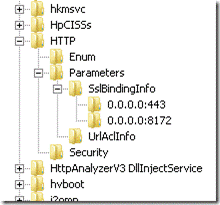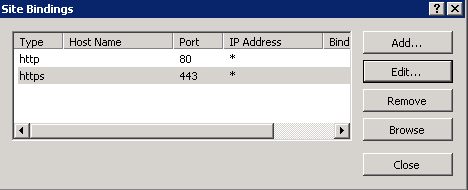SSL Bindings are randomly getting deleted for a website with error "SSL Certificate Settings deleted for Port : X.X.X.X:443" in the event logs (IIS 7.0/7.5)
Symptoms
Are you getting into a scenario wherein randomly your Website loses or changes the SSL certificate bindings from within the IIS manager? And you realize it only when users complain that they are unable to reach the HTTPS site, or that they get a certificate warning. They are able to access the website over HTTP but not over HTTPS because the certificate binding is lost for the website, or they may be prompted that the certificate is expired, or the site name is incorrect. At this point of time you also notice that System Event log entry shows the following:
Log Name: System
Source: Microsoft-Windows-HttpEvent
Date: 3/31/2010 2:43:28 PM
Event ID: 15300
Task Category: None
Level: Warning
Keywords: Classic
User: N/A
Computer: myMachine
Description:
SSL Certificate Settings deleted for Port : 0.0.0.0:443 .
If you go to the IIS manager and check the bindings for the Website in question you will see either the certificate binding is lost or some other certificate is listed.
You can also crosscheck the registry entry below for your IP/Port binding associated with your website and you may find it deleted.
HKLM\System\CurrentControlSet\SERVICES\HTTP\Parameters\SslBindingInfo\X.X.X.X:443
Here is how it looks if you have the proper binding set at the http.sys level in the Registry.
Note: Should the certificate be changed, the binding will look the same.
Assessment
If you are experiencing the above problem it could be related to the following <customMetadata> tag in your ApplicationHost.config.
<key path="LM/W3SVC/X">
<property id="5506" dataType="Binary" userType="1" attributes="None" value="oXiHOzFAMOF0YxIuI7soWvDFEzg=" />
</key>
The above property is used to store a SSL certificate hash. It is specifically the ID 5506 entry you need to check for. That ID is the legacy property for certificate hash. Whenever any application/service which depends upon the ABO mapper runs/starts, it tries to initialize the ABO tree structure which includes generating custom nodes and properties. During this process it reads from this custom metadata section and tries to map the properties in the ABO tree structure. During mapping it deletes the current SSL mapping(s) at the http.sys level and recreates a new one using the above hash value. If this value is invalid for some reason it fails to add the new entry for SSL binding at the http.sys level. So in such a case the above registry key does not have an entry for the website’s IP:Port combination corresponding to the SSL setting in the UI like below:
Call stack output
If you use the Debugging Tools for Windows and the Microsoft symbol server to attach to the process Inetinfo.exe, you will notice a call stack that resembles the following below:
abocomp!UpdateSSLProperty
abocomp!SITE_CUSTOM_PROVIDER::MapSetData+0x371
abocomp!ABO_NODE::MapSetData+0xd9
abocomp!ABO_NODE::SetData+0xbd
abocomp!ABO_TREE::SetCustomProperty+0x34a
abocomp!ABO_TREE::GenerateCustomNodesAndProperties+0x1ad
abocomp!ABO_TREE::GenerateTree+0x28d
abocomp!ABO_WRAPPER::InitializeTreeAndState+0xad
abocomp!ABO_WRAPPER::GetCurrentAboTree+0xc7
abocomp!ABO_WRAPPER::OpenKey+0x154
COADMIN!CADMCOMW::OpenKeyHelper+0x172
COADMIN!CADMCOMW::OpenKey+0x53
RPCRT4!Invoke+0x65
RPCRT4!NdrStubCall2+0x348
RPCRT4!CStdStubBuffer_Invoke+0x9a
ole32!SyncStubInvoke+0x5d
ole32!StubInvoke+0xdf
ole32!CCtxComChnl::ContextInvoke+0x19f
ole32!AppInvoke+0xc2
ole32!ComInvokeWithLockAndIPID+0x407
ole32!ThreadInvoke+0x1f0
RPCRT4!DispatchToStubInCNoAvrf+0x14
RPCRT4!RPC_INTERFACE::DispatchToStubWorker+0x100
RPCRT4!RPC_INTERFACE::DispatchToStub+0x62
RPCRT4!RPC_INTERFACE::DispatchToStubWithObject+0x5b
RPCRT4!LRPC_SCALL::DispatchRequest+0x436
RPCRT4!LRPC_SCALL::HandleRequest+0x200
RPCRT4!LRPC_ADDRESS::ProcessIO+0x44a
RPCRT4!LOADABLE_TRANSPORT::ProcessIOEvents+0x24a
RPCRT4!ProcessIOEventsWrapper+0x9
RPCRT4!BaseCachedThreadRoutine+0x94
RPCRT4!ThreadStartRoutine+0x24
kernel32!BaseThreadInitThunk+0xd
ntdll!RtlUserThreadStart+0x1d
We break into the function which calls into the HTTP.sys at the kernel mode to delete the SslBindingInfo Registry key.
Steps to reproduce
We can reproduce this issue at will by adding the following under <CustomMetadata> section of your applicationhost.config file
<key path="LM/W3SVC/X">
<property id="5506" dataType="Binary" userType="1" attributes="None" value="oXiHOzFAMOF0YxIuI7soWvDFEzg=" />
</key>
and then launching any application which requires ABO Mapper, for e.g. launching Inetmgr6.exe or enumerating using ADSUTIL VBscript.
Resolution
This property is a legacy feature from IIS 6 days and ported onto IIS 7+. If we have correctly added the certificate in the IIS manager this specific property with id 5506 is not needed. Search for the above entry in your ApplicationHost.config file and remove the property in case you are seeing the above issue.
PS: I have got the above issue/resolution recently documented as a fast-publish KB article 2025598.
till next time
Comments
Anonymous
March 29, 2011
Awesome! :) I didn't know this one. This will help me indeed.Anonymous
June 06, 2011
I was plagued by this same issue, and it seems your fix has got us back to stable where SSL certificates are still selected for sites after an IISRESET. Thanks for postingAnonymous
March 22, 2012
we have this problem and our ApplicationHost.config file does not have the 5506 entryAnonymous
July 26, 2012
I am in the same position as Gregski...no 5506 entry.Anonymous
November 14, 2013
Hello, I don´t have the Id=5506 entry in the ApplicationHost.config, and I still have the problem. Any help. Thanks.Anonymous
July 08, 2014
We dont see this property ID at our environment, but the issue does happen.Anonymous
September 04, 2014
I had this issue on ii8 and an SCCM distribution point running https mode. comparing a known-good host, the bad host had this extra config which was recreating the sslbinding regkeys: <key path="LM/W3SVC/1"> <property id="5511" dataType="String" userType="1" attributes="Inherit" value="" /> <property id="2161" dataType="DWord" userType="1" attributes="Inherit" value="0" /> </key> I'm not an IIS person, so I just took a chance on these two Property IDs causing the problem. Once i removed this key path, the 443 binding stuck.Anonymous
April 28, 2016
This worked perfectly to resolve a legacy app we have on an upgraded W2K8 / IIS 7.0 machine, thanks!Anonymous
November 29, 2017
Thank you. Worked like a charm. Everything is stable now.

